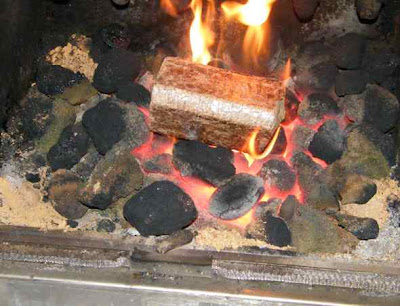.
A 2nd Look
at some characteristics of
Wood Briquettes
at some characteristics of
Wood Briquettes
I has been suggested to me that my initial assessment of some wood products was not scientific and was inaccurate. I do not aim to be a scientific authority, or indeed any sort of authority on the subjects I write about. The opinions are my honest impressions, backed up in any way I can with some bit of science.
So today I take a closer look at one type of compressed wood briquette log - it has a somewhat square profile and is the pale type of briquette.
I have taken a 14cm piece of the briquette and placed it on a hot fire. After some 15 minutes, I measured it and it had expanded to about 20cm. After a period of some 30 minutes it had expanded in length to 26cm.
In expanding, it had become segmented and very soft and flaky. When the door was opened and the air got to it, it burned really quickly.
You can see here where the mass breaks up and starts to get spongy
After approximately 1 hour it has just about gone
I appreciate I am not able to be highly scientific, but you will see from my simple experiment that the paler type of wood briquette log rapidly expands to, in this case almost twice its original length, some other types expand even more.
When the mass expands, it allows more oxygen to mix through the fuel and speed up the combustion. This is not perhaps a good feature in fuel for stoves etc.
I have no argument with the total heat output or other factors of this type of fuel which may prove highly satisfactory in many situations. However, when the mass expands 2x times or more and becomes porous and spongy, the burn rate is going to change a great deal and it will be difficult or impossible to get extended burn times. Expanding mass will also cause the fuel to push out against the glass of a stove or over the edge of a grate.
.







No comments:
Post a Comment